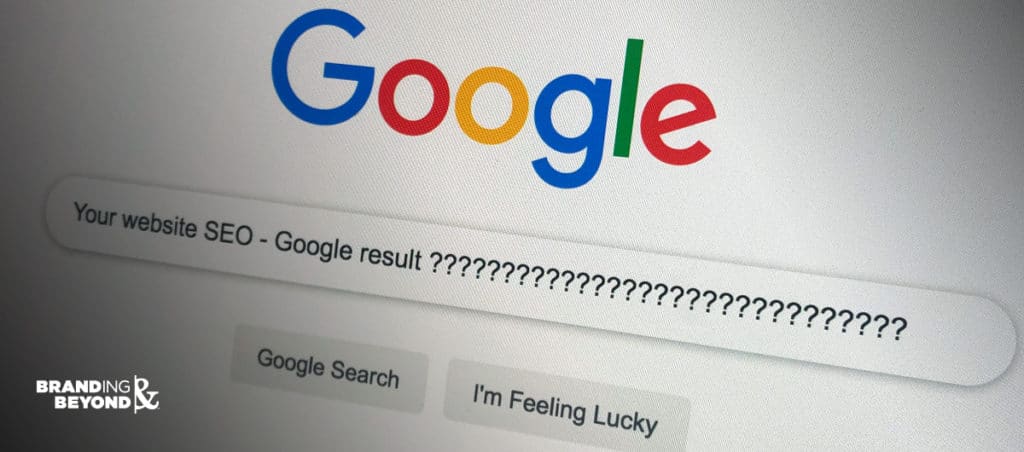
Devastating SEO Issues That Cause Your Website to Be Invisible to Google
Your website has two main audiences: search engines and your target market(s).
At our core, we are problem solvers. When friends, colleagues, and clients run into problems with their website or have a branding issue, we get called to consult.
Today, we're going to cover what makes a website invisible to Google and how to fix the low-hanging fruit.
So, let's get started with a quick story about a good friend of mine, that I've known for many years, and how a bad SEO practice/implementation pretty much screwed up an entire website project for her.
We'll call her Angela. Angela built a site for a local business with a designer who designs beautiful websites at a very low price. He designs pretty mockups and sends them off to his team in India, and they build it as is.
What's wrong with that?
Potentially, a lot.
In this case, a hell of a lot.
After 8 months of being live, the website was nowhere to be found on Google… at all. So, Angela called me and asked if I could take a look to see what could be the problem. She said her designer is good but doesn’t do much with search engine optimization or site maintenance.
Well, I logged in and holy crap.
An offshore team isn't the issue; it's the disconnect between the content, design, and development. The two main end-users (search engines and your target audience) are often a blip in the conversation. THEY should BE the conversation. They should be the core of the strategy. Why build a site if it isn't for the end-users? The content is for them; the design should please and aide them; the development should be invisible and seamless.
Here’s a brief list of the issues we found:
- No Google Analytics – tracks visitors to the site and lets you know if you're delivering what they're looking for
- No Google Search Console – submit sitemaps, tools, and reports to help you measure your site's Search traffic and performance.
- No Google My Business account – improves Google ranking and helps customers find you.
- No XML sitemap (Again, gives Google the info it needs to classify and ‘see' your site)
- ^^^ These 4 things are conversations with Google. The first one is Google to you, and the others are you to Google. Stop being invisible to Google.
- No meta titles, meta descriptions, meta tags or alt tags on images – these all help Google classify what the site does and who to show it to
- No keyword analysis, they were actually using words in their content that their industry never uses (Google needs keywords to see what you're talking about and categorize you)
- No SSL cert – A Google requirement these days (its the s in https://)
- No site backups – Ok this isn't really to do with SEO, but c'mon this seriously saves your butt if something goes wrong with the site or God forbid you to get hacked since there is no security or maintenance!
- No site security – Good for Google, good for visitors, good for you
- No site maintenance or updates – Outdated websites get hacked more, simple.
- No citation campaigns – getting all the information about your company into or listed correctly in the database aggregators. Data aggregators are where a lot of websites get the info about you that they list on their sites.
That was just the backend issues. On top of that, the site was meant to be B2B but looked and read like it was for a consumer. It was a well designed attractive site, but it was not built for the intended user and what they care about. The purpose of the company was not immediately clear.
When you build a website, you have two main audiences, search engines, and your target market(s). This article is about search engines, but seriously, don't forget about the people your firm was built to serve. They need to be able to find you, quickly ascertain that you were built for them, and stick around long enough to either remember you or start building a relationship.
“Oh that’s on the about page”… don’t expect a user will make it past your homepage if it looks like they are in the wrong place. Don’t make them work so damned hard.
Sound like a lot of issues for one website?
It is. And this is the short, brief list of issues – you can imagine my reaction stumbling into this.
“THIS is why you don't build your website with the lowest bid.”
When it comes to writing and building a website, you need to tick some really basic checkpoints if you want Google to know you exist, let alone outrank your competitors.
So, without further ado, here's our guide to the basics of search engine optimization (or, hey your website doesn't have these? Expect it to suck on the search engines)
SEO Problems That Can Affect Your Website’s Performance
1. You don’t know/understand your audience
Knowing or understanding your audience comes down to research. Even if you've worked in your industry for decades, you need to do audience research before building your website.
What your target audience wants changes over time. With advances in technology, shifts in the industry, and younger generations coming into the market, customers aren't looking for the same information or selling points they were five years ago.
Looking into the type of people you're trying to attract, understanding what they care about and what they worry about will help your website speak directly to them. Empathy in your content strategy enables you to stop being invisible to Google.
2. Your content is confusing, bland, watered-down, jargon-filled and doesn't say much
Your content should be written before your website is built – it's the most important aspect of your website, turning casual visitors into loyal customers.
A lot of writers won't start until there is a design mockup to write to. That is backward. Unless your designer is a strategist, like ours, you shouldn't let them drive the flow or story of the site.
Not understanding what your target market is looking for will make you invisible to Google.
A key part of your content writing is keyword analysis and research. Basically, keywords and key phrases are the search terms your target audience is typing into Google and looking for help with.
When you answer these questions on your website and talk about the topics they're searching for; Google will start recognizing the value you have to people looking for those things. The result? You rank higher on Google's results for those search terms.
Don't even THINK about putting in random words and search terms into your website's content. People hate it, Google hates it, and your website will suck as a result. It's called keyword stuffing, and it's terrible, please don't do it.
If you're not hiring a professional to write your website's content for you, make sure you write in a natural, approachable way. When you talk about what you do best, you'll find that you include your keywords without having to think about it.
Pro tip: Add FAQ sections to your website, not only do they help people browsing your site, they help you include extra search phrases and questions. Make sure to get in layman terms, alternate phrasings and spellings.
3. Your site has no logical layout
For this point, we're referring to the sitemap (or the way your pages fit together within the site).
Your website needs to be readable for search engines but also easy for visitors to navigate. An essential thing to add from a ranking-on-Google point of view is a sitemap of your site. So many companies neglect this and get penalized by Google as a result.
A pet-peeve of ours is pages that have no point or having to click around too much to find the data that should be easy to find. Every single page on your site should have a reason to live. Pages with little to no content will help you be invisible to Google. Use drop-down navigation instead to make it easy for your users to view the subjects on your site quickly.
If you confuse you lose!
4. You don't maintain your website
This isn't negotiable – you need to have a security and maintenance plan implemented for your website; especially if you are on WordPress. We love WP, but they are a big target, and hackers love to look for weak spots. Don't be low-hanging hacker fruit.
At the very, very least, you MUST have an SSL certificate on your website. When installed on a web server, an SSL cert activates the padlock and the https protocol and allows secure connections from a web server to a browser. Basically, it lets visitors and Google know that you care about their private data and do your best to avoid getting hacked.
You should have a framework in place to let you know if your site's security is breached and have the ability to take backups of your website's files, just in case something happens down the road.
Gone are the days of set it and forget it, then knock it over and rebuild, forget it, knock it over… Your website is a living asset that should grow along with you. Sites that are not updated become invisible to Google.
At the very fundamental end of the scale, you need to be implementing all of these points to get your website operating at a very basic level. If you don't, Google will most likely not recognize your website, and potential customers won't be able to find you online.
You might be wondering what happened to Angela's customer.
Well, I got my team here at Branding & Beyond on the case.
We started with a website audit, relaid out the homepage, altered the navigation scheme, updated key content, did some keyword research, fixed the backend issues, added an SSL certificate, added backups, and security. Basically, we righted all the wrongs set out above (and then some). We launched a massive citation campaign to get the site more exposure and recognition.
The result?
- 125 key phrases listed 1-3 in Google
- Domain authority from 0 to 12 (it's only been a few months)
- Getting listed in 21 new aggregators
- Going from 5% organic traffic to 65% organic traffic (customers who find your listing by searching vs. a direct link)
- 82% bounce rate to 41%
- Getting listed in the Google map pack
- Page sessions from 1.87 to 8.44 average pages viewed per session
- Time on site from less than a minute to over 8 minutes
There is still work to do but going from being invisible for 8 months after a site launch to being visible within a few months of back end + SEO + citation work… not bad.
Are you feeling lost in Google? Is your website giving you nothing, despite you trying your best to invest in it? We can help. Let's solve your site's problems TODAY.
Here are a few other articles you might like:
Tracy O’Shaughnessy Founder / Lead Brand Strategist of Branding & Beyond
Tracy and her team help firms in and around the B2B building trades look and sound credible online and off.
She has been in the industry since the early '90s and is tired of seeing fantastic firms struggle, blend in, and get bypassed by prospects who judge them solely on the outdated information found online.
Branding & Beyond's mission is to solve real business problems and build the brand foundation clients need to get noticed and hired.
You can find Tracy on Linkedin and here on this blog.
